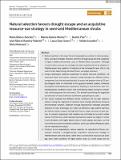Por favor, use este identificador para citar o enlazar a este item:
http://hdl.handle.net/10261/279202COMPARTIR / EXPORTAR:
 SHARE SHARE
 CORE
BASE CORE
BASE
|
|
| Visualizar otros formatos: MARC | Dublin Core | RDF | ORE | MODS | METS | DIDL | DATACITE | |

| Título: | Natural selection favours drought escape and an acquisitive resource-use strategy in semi-arid Mediterranean shrubs |
Autor: | Blanco-Sánchez, Mario; Ramos-Muñoz, Marina; Pías, Beatriz CSIC ORCID; Ramírez Valiente, José Alberto; Díaz-Guerra, Laura; Escudero, Adrián; Matesanz, Silvia CSIC ORCID | Palabras clave: | Acquisitive strategy Gypsum specialists Individual fitness Mediterranean Natural selection Phenotypic selection Selection differential Stress escape |
Fecha de publicación: | 24-jun-2022 | Editor: | British Ecological Society | Citación: | Functional Ecology Functional Ecology 36(9): 2289-2302 (2022) | Resumen: | Natural selection is the major force driving adaptive evolution in natural populations, varying in strength, direction, and form through space and time, especially in highly variable environments such as Mediterranean ecosystems. Although a conservative resource-use strategy has been hypothesized to be adaptive in Mediterranean taxa, patterns of selection at the intraspecific level, that is, the suite of traits determining individual fitness, are largely unknown. Using a phenotypic selection experiment in natural semi-arid conditions, we measured direct and indirect selection acting through two different fitness components (survival and reproduction), to assess the adaptive value of 20 ecophysiological traits on individuals of two gypsum endemic species, Centaurea hyssopifolia and Helianthemum squamatum, dwelling in environments with contrasting abiotic conditions (south- and north-facing slopes) during two climatically contrasting years (dry and mesic). This allowed quantifying the magnitude and direction of natural selection at different spatiotemporal scales. Our results revealed that different abiotic conditions did not alter selection patterns, being the magnitude of selection more strongly affected by temporal environmental variation. Selection through reproduction indicated consistent selection for early phenology, low water use efficiency, high specific leaf area, low leaf dry matter content, and high leaf N across slopes and years in both species. In contrast, phenotypic trait variation was not linked to survival in either species. Furthermore, while individual reproductive output was higher or similar in environments with higher abiotic stress in both species and years, survival was similar across environmental conditions, and it was neither affected by plant size nor reproductive output. Contrary to our expectations, natural selection via reproductive fitness consistently favoured a drought-escape, acquisitive resource-use strategy in Mediterranean semi-arid plants, rather than a conservative resource-use strategy, even under conditions of higher abiotic stress (i.e. south slopes and dry year). Such acquisitive strategy could allow rapid development by maximizing resource assimilation and reproduction before the most limiting climatic conditions of mid-late summer. Our results shed light on adaptive functional strategies of Mediterranean taxa at the intraspecific level, providing insight on future responses to environmental change, and highlight remarkable differences in selection acting through different fitness components. Read the free Plain Language Summary for this article on the Journal blog. | Descripción: | 14Pág. Centro de Investigación Forestal (CIFOR) | Versión del editor: | https://doi.org/10.1111/1365-2435.14121 | URI: | http://hdl.handle.net/10261/279202 | DOI: | 10.1111/1365-2435.14121 | ISSN: | 0269-8463 |
| Aparece en las colecciones: | (INIA) Artículos |
Ficheros en este ítem:
| Fichero | Descripción | Tamaño | Formato | |
|---|---|---|---|---|
| Natural-selection-favours-drought-escape.pdf | artículo | 3,32 MB | Adobe PDF |  Visualizar/Abrir |
CORE Recommender
SCOPUSTM
Citations
8
checked on 14-may-2024
WEB OF SCIENCETM
Citations
8
checked on 26-feb-2024
Page view(s)
32
checked on 16-may-2024
Download(s)
30
checked on 16-may-2024
Google ScholarTM
Check
Altmetric
Altmetric
Este item está licenciado bajo una Licencia Creative Commons

